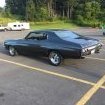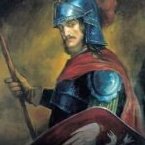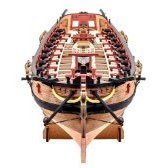-
Posts
9,937 -
Joined
-
Last visited
Reputation Activity
-
 ccoyle got a reaction from JayCub in Kitamaebune by catopower - Woody Joe - 1/72 scale
ccoyle got a reaction from JayCub in Kitamaebune by catopower - Woody Joe - 1/72 scale
Your diorama received a well-deserved post at our FB page.
-
 ccoyle reacted to allanyed in Hello From France
ccoyle reacted to allanyed in Hello From France
Bonjour Besson and welcome to MSW. Someone will no doubt reply that this an English only forum but I hope you stay with us. In the meantime I have an edited Google translation of your note below.
pas de quoi, ciao, cheers, &c.
Allan
Hello to all friends on the other side of the Atlantic. You have here a very elaborate forum full of tips and building techniques. I discovered this site through Pinterest and I don't regret it. I started model making a long time ago (alas) by building radio controlled planes which fell too often !. In love with the sea, I therefore relied on boats sailing and sinking only very rarely. After an interruption of a good decade of this leisure for professional reasons, one day, while surfing the net, I had the opportunity to discover photographs of models of 18th century ships built with the framework represented in the Admiralty method. There, it was a great shock. The complexity and finesse of the work of the model makers presenting their work made me fall in admiration for such great successes. I asked myself the question of knowing if I would be able to arrive at the lowest rung of the ladder of these of these men. So I first looked at all the books dealing with the construction of vessels and in this matter there is something to read. It already took me two good years and at the same time I tried to make a small boat following a plan of Chapman. This experience, which was far from perfect, did not discourage me and I decided to embark on the adventure of the "Big Belly" which had a forum at the time, which like the yours, allowed the model makers to present the progress of their model and to glean the information necessary for the good completion of their model. I spent five years to build the hull and it is not completely finished because I moved by changing the region and the fittings of my new house stopped the construction of my model. However the demon of model making begins to recover me and I would like to start again with a small model of longboat in kit (the pre-cut members will relieve my joints of 72 springs) So there you are, if the shipments can be made to Europe, I would be delighted to join you. Good evening to all
-
 ccoyle reacted to Bishophobbies in Brigantine Phoenix by Bishophobbies - Master Korabel - Scale 1:72
ccoyle reacted to Bishophobbies in Brigantine Phoenix by Bishophobbies - Master Korabel - Scale 1:72
Ok - I'm back on the job. I'm going to finish this thing. The first thing I've done is hang up some of the ship plans then sort the various dowels in the kit according to their callout on the plans.
I've also included some pics of my small work area.
-
 ccoyle reacted to catopower in Kitamaebune by catopower - Woody Joe - 1/72 scale
ccoyle reacted to catopower in Kitamaebune by catopower - Woody Joe - 1/72 scale
Hey, while I'm at it, I might as well litter my own build log with something else I finished up as a quick side project – this is Woody Joe's Nihonbashi Bridge kit.
I've had this kit in the stash for about a year. I decided I needed to make something simple over the holidays, so I pulled this one out. It was a really fun and pretty easy build.
Would have been easier, except I wanted to add figures. Also, I wanted more realistic looking boats than what was in the kit. So, I scratch built some...
I added some small details and I did have fun painting the figures, though I decided to buy some new Vallejo paints for the job.
The water is from Woodland Scenics. The cherry blossom trees are made by Woody Joe and included in the kit.
Okay, now back to our regular programming!
Clare
-
 ccoyle reacted to JPAM in Sandolo buranello by JPAM - FINISHED - GILBERTO PENZO - Scalla 1:18 - SMALL
ccoyle reacted to JPAM in Sandolo buranello by JPAM - FINISHED - GILBERTO PENZO - Scalla 1:18 - SMALL
as there are no right angles on this boat it's difficult to use brackets as you would in a traditional POB hull. i found after some dry runs that be best way to attach the hull sides is to glue both of them to the center thwart. also it's best to use tape and rubber bands to hold the model together as the glue sets. I am using white glue instead of CA. the model will need to be painted before completion so i will have to research traditional painting schemes.
-
 ccoyle got a reaction from Duanelaker in Phoenix by Moreplovac - FINISHED - Master Korabel - 1/72 - Russian Brigantine
ccoyle got a reaction from Duanelaker in Phoenix by Moreplovac - FINISHED - Master Korabel - 1/72 - Russian Brigantine
I haven't yet been able to get back to my build of MK's gunboat, but it is an excellent kit in all respects. Based on what we have seen in other Phoenix build logs, I think you will get a lot of pleasure out of this project.
Cheers!
-
 ccoyle got a reaction from moreplovac in Phoenix by Moreplovac - FINISHED - Master Korabel - 1/72 - Russian Brigantine
ccoyle got a reaction from moreplovac in Phoenix by Moreplovac - FINISHED - Master Korabel - 1/72 - Russian Brigantine
I haven't yet been able to get back to my build of MK's gunboat, but it is an excellent kit in all respects. Based on what we have seen in other Phoenix build logs, I think you will get a lot of pleasure out of this project.
Cheers!
-
 ccoyle got a reaction from Ronald-V in MASTER-KORABEL NEWS
ccoyle got a reaction from Ronald-V in MASTER-KORABEL NEWS
I hope we will be seeing a full kit unboxing and review here at MSW (hint, hint)? 😉
-
 ccoyle got a reaction from greenstone in MASTER-KORABEL NEWS
ccoyle got a reaction from greenstone in MASTER-KORABEL NEWS
I hope we will be seeing a full kit unboxing and review here at MSW (hint, hint)? 😉
-
 ccoyle got a reaction from mtaylor in MASTER-KORABEL NEWS
ccoyle got a reaction from mtaylor in MASTER-KORABEL NEWS
I hope we will be seeing a full kit unboxing and review here at MSW (hint, hint)? 😉
-
 ccoyle got a reaction from Old Collingwood in ORP Ślązak (ex German A59) by RGL - FINISHED - Mirage Hobby - 1/350 - PLASTIC - Polish Torpedo boat
ccoyle got a reaction from Old Collingwood in ORP Ślązak (ex German A59) by RGL - FINISHED - Mirage Hobby - 1/350 - PLASTIC - Polish Torpedo boat
Goodness, Greg! At the rate you work, I may be able to tag this build as finished later this afternoon!
-
 ccoyle reacted to moreplovac in Phoenix by Moreplovac - FINISHED - Master Korabel - 1/72 - Russian Brigantine
ccoyle reacted to moreplovac in Phoenix by Moreplovac - FINISHED - Master Korabel - 1/72 - Russian Brigantine
So, lets see what we have here..
The box..
Instructions in Russians..
..and in English..
Rigging info...
Translated plan, not in 1:1 scale dough..
Instruction booklet does not include rigging info...
Material for making sails. There is an option to buy a fully completed sails if there is a desire for it..
Small parts.. of very good quality..
Ropes included in the kit..
More small parts..
Ship's boat...
Original plans..
Cannot help and not to compare with some other manufacturer's build plan on which you cannot actually see all required details.. This plan just stands out very much in quality and precision.
The laser cut parts are nicely protected and covered in plastic foliage to prevent breakage.
So, that it is for start. Looking forward to actually get my hands dirty..
Happy modeling..
-
 ccoyle reacted to moreplovac in Phoenix by Moreplovac - FINISHED - Master Korabel - 1/72 - Russian Brigantine
ccoyle reacted to moreplovac in Phoenix by Moreplovac - FINISHED - Master Korabel - 1/72 - Russian Brigantine
It is time to start a new build log.
This time it was a close race between brigantine Phoenix and USS Syren. Since Phoenix kit has all laser cut parts, including planks, i was curious to see how this approach fits into hard-core, make-my-own planks state of mind... So, let see...
This is a wooden model kit of the 12-gun brigantine "Phoenix" - cruising ship with a sailing arsenal of the brigantine, part of Black Sea Fleet of the Russian Empire.
St. Andrew's flag Russia
Ship class and type Cruising ship
Type of sailing equipment brigantine
Organization Black Sea Fleet
Commissioned since 1787 in Russia
Removed from the fleet Autumn 1803
Length between perpendiculars 24.4 m
Mid- width width 7.3 m
Draft 2.9 m
Mover sail
Crew 52
Total number of guns 12 guns
Service history (obtained from Internet sources).
A Greek built 12-gun brigantine Phoenix became a part of the Russian Black Sea fleet in 1787. With a war with Ottoman Empire pending, large number of Greek Corsair ships were purchased to strengthen the young Russian Black Sea fleet, in many cases the Greek crews were also hired into Russian service. Such ships were officially classified as “cruising ships” in Russian navy lists. The ship’s first war was the Russian-Turkish war of 1787-1791.
In the summer of 1788, the ship under the command of warrant officer Georgy Nikiforovich Benardaki, as part of Rear-Admiral's squadron Count M. I. Voinovich , went to sea in search of the enemy. On July 3, 1788, the brigantine participated in the first naval battle of the Russian-Turkish war of 1787-1791 near Fidonisi between the fleets of Russia and the Ottoman Empire. In 1789, as part of squads and squadrons, she repeatedly went to sea to search for Turkish ships.
In April 1790, the ship delivered supplies and materials from Kherson to Sevastopol. In May 1790, with the squadron of Rear Admiral F. F. Ushakov, along with other cruiser ships, searched for Turkish ships, participated in the blockade of Anapa, in the battle near the Kerch Strait (was in reserve).
In August 1790, in a battle near the island of Tendra, captured 10 Turkish cannon brigantine. In October, the captured Turkish ships escorted to the Dnieper Liman to Ochakov. In November, together with the cruising ship “Clement Pope of Rome” was sent to cruise to the Rumelian coast in the Varna region - m. Kaliakria. They took two Turkish vessels Sakaleva and Tumbaz (captured flooded) from Varna, then returned to Sevastopol and brought the captured vessel Sakaleva there. In April 1791, ships again went to search for Turkish ships to the shores of Tavrida, and then to the Anatolian coast - from Sinop to Constantinople. April 1 sunk two Turkish vessels. In July, the ship in the squadron F. F. Ushakov went to sea. July 31, participated in the battle at Cape Kaliakria.
In 1794, the Phoenix under the command of midshipman S. A. Belisarius with a squadron was on a practical voyage in the Black Sea, and in 1795-1797 in the Black and Azov Seas.
In the war with France of 1798–1800, the ship under the command of Lieutenant L. F. Morskoi was used as a transport ship. In November 1798, the ship arrived from Sevastopol to Corfu with provisions for the squadron of Vice-Admiral F. F. Ushakov. In December 1798, FF Ushakov's demands to Ibrahim Pasha delivered to Avpona to send Turkish troops to storm Corfu, blocking the fortress. At the beginning of 1799 the ship was with a squadron at Corfu, escorting transport ships with captured Frenchmen, entered Messina and arrived in Toulon. In 1801 and 1802 the brigantine sailed between the ports of the Black Sea.
In 1803, the ship was under the command of Lieutenant S. S. Karachinsky with the Nikolaev Nort, dismantled after 1803 in Nikolaev.
Cruise Ship Commanders:
G. N. Benardaki (1788–1791);
S. A. Belisarius (1794-1798);
LF Morskoy (1797-1802) [2] ;
S. S. Karachinskaya (1803) [3] .
Literature:
Chernyshev A. А. Russian sailing fleet. Directory. - M .: Military Publishing, 2002. - T. 2. - 480 p. - (Ships and vessels of the Russian fleet). - 5000 copies - ISBN 5-203-01789-1 .
Veselago F. F. The General Maritime List from the base of the fleet until 1917. - SPb. : Printing house of V. Demakova, 1890. - V. IV / The reign of Catherine II. K - S. - S. 31, 398. - 712 p. - (Military history library).
A. B. Shirokorad. 200 Years of the Sailing Fleet of Russia / Ed. A. B. Vasiliev. - 2nd ed. - M .: “Veche”, 2007. - 448 p. - ISBN 978-5-9533-1517-3 .
Model details:
Scale 1:72.
Assembled dimensions are (LxWxH) 23.25" x 8.5" x 17.25" (590mm x 220mm x 440mm ).
All wooden parts are laser cut to simplify assembly.
Hull design compensates for material deformations.
Double plank-on-bulkhead hull. Final hull planks are made of anigre veneer.
Historically accurate cast cannons with Russian Imperial crests.
Laser etched deck made of maple veneer.
High quality pearwood blocks.
Multitude of highly detailed brass parts.
Sail plans and cloth for sewing the sails.
Silk screen flags.
Different diameters of black and tan threads for standing and running rigging.
Ship stand with two nameplates, one in English and one in Russian
Binnacle.
Ship's boat MK0101 is included.
Ship plans (four large sheets) and translated plans in English.
Assembly instructions in English.
Made in Russia by Master Korabel
Happy modeling.
-
 ccoyle reacted to MSW in Now hear this! Regarding Third-Party Hosting
ccoyle reacted to MSW in Now hear this! Regarding Third-Party Hosting
Ahoy, mates!
As a reminder, please do not use off-site hosts for images that you use in your posts. Doing so can potentially cause two problems. First, the hosting site may have protection protocols in place that do not allow your images to be seen at our site; these protocols can adversely affect the functionally of MSW. Second, if the off-site host goes belly-up, or if you terminate your account with them, your links at MSW will be dead, which rather limits their usefulness.
We have plenty of image-hosting capability on-site here, so the best way to share your images at MSW is to directly upload them to MSW.
Any posts made here that link to off-site hosts may, out of necessity, be taken down without notice.
Thanks for your cooperation!
-
 ccoyle reacted to BlackSeraph in America by BlackSeraph - BlueJacket Shipcrafters - 1/4" scale
ccoyle reacted to BlackSeraph in America by BlackSeraph - BlueJacket Shipcrafters - 1/4" scale
The keyword for this post is "mistakes".
Please don't forget this is a build log a not building instructions.
The most important thing one should do is to cut keel slots of proper size, so the frames will stay in place by themselves. This will save you lot of pain and few years of your life.
The last 5-6 frames have recessed timberheads. The frames must be fixed so the measurements can be made and see how it looks. As is indicated in building book.
I tried to fix frames with rubber glue, but is too flexible. Then I challenged gods and I worked by measuring everything. It doesn't work well, there are differences between frames around 1mm, is the best I could produce.
I built the stern using the milled piece of wood. Measured on plans, dimensions and curves. Tested and affixed on horn.
BIG MISTAKE. After I fixed the last frame I realized that the hull curve doesn't match. The sides are correct, but under hull curve is more steep. So I cut the horn, unglued it from stern, cut a slot for it and then tested again. Better, but still not good.
It can be seen in a previous picture that there is steep differences between last frame and stern. I think that @gsdpic is right and lots of material must be removed. I will fix all frames, then fair (?) them and see how I can solve stern issues.
Another HUGE problem is the wood, which is soft. As I said, the last frames have recessed timberhead. The shape is a bit complex and the wood breaks easily. Like 5 times a timberhead.
So, what I did was to half cut the timberhead and fix the frame. And use a vise to keep the frame tight; I didn't break anything after that. Then, when all are in place, I will mark it and cut it in place.
All this pain could've been avoided if keel slots were cut right!
On a different topic, I struggled to measure and keep in place at right angle the frames. And keep the keel from moving. For this I reused a piece from plexiglass board and that gave me some ideas about a system. I designed it, I need someone to cut the pieces for me.
I'm very excited to see it done. Keep close, is pretty crazy.
-
 ccoyle reacted to BlackSeraph in America by BlackSeraph - BlueJacket Shipcrafters - 1/4" scale
ccoyle reacted to BlackSeraph in America by BlackSeraph - BlueJacket Shipcrafters - 1/4" scale
Got this kit from BlueJacket because I want to make transition to scratch built from kits. I hope it will help with some techniques, hopefully.
The kit seems good, lots of material and fittings
-
 ccoyle got a reaction from JpR62 in MASTER-KORABEL NEWS
ccoyle got a reaction from JpR62 in MASTER-KORABEL NEWS
I hope we will be seeing a full kit unboxing and review here at MSW (hint, hint)? 😉
-
 ccoyle got a reaction from VTHokiEE in MASTER-KORABEL NEWS
ccoyle got a reaction from VTHokiEE in MASTER-KORABEL NEWS
I hope we will be seeing a full kit unboxing and review here at MSW (hint, hint)? 😉
-
 ccoyle got a reaction from James H in MASTER-KORABEL NEWS
ccoyle got a reaction from James H in MASTER-KORABEL NEWS
I hope we will be seeing a full kit unboxing and review here at MSW (hint, hint)? 😉
-
 ccoyle reacted to RGL in ORP Ślązak (ex German A59) by RGL - FINISHED - Mirage Hobby - 1/350 - PLASTIC - Polish Torpedo boat
ccoyle reacted to RGL in ORP Ślązak (ex German A59) by RGL - FINISHED - Mirage Hobby - 1/350 - PLASTIC - Polish Torpedo boat
As you can see, this is tiny after an aircraft carrier.
-
 ccoyle reacted to EricWilliamMarshall in Opium Smuggler 1806 by EricWilliamMarshall - FINISHED - Authentic Models - Scale 1:75 - Schooner
ccoyle reacted to EricWilliamMarshall in Opium Smuggler 1806 by EricWilliamMarshall - FINISHED - Authentic Models - Scale 1:75 - Schooner
More work on the deck, a bit of hull shaping and one bulwark attached! The runs of decking were sliced with an xacto blade then I used a small brush to add a bit of brown stain to hide the fresh cut of the wood. The photo shows the deck after a coat of varnish.
-
 ccoyle reacted to greenstone in MASTER-KORABEL NEWS
ccoyle reacted to greenstone in MASTER-KORABEL NEWS
Gentlemen, with great pleasure I want to show a new model!
The model was built by Yura Kimborovich according only to our drawings by "MasterKorabel"
Drawings we prepared on the basis of archival information of the 1840s. to develop a new kit.
This is a 20-oar 42-foot longboat #1 of the 120-gun battleship “Twelve Apostles” - the flagship of Admiral Lazarev of the Black Sea Fleet.
Date: 1841 -1855
Sailing: the Plymouth bot.
Art.: one 24-pound carronade. 80 shots.
Crew: Midshipman, 160 marines and 22 sailors.
Soon we will release this kit on sale.
art. 0304
Scale 1: 48
length - 498.5 mm,
width - 80 mm,
height - 350 mm
P.S. The model was built during the development of the new kit, so the final version of the kit will naturally differ slightly from this model.
-

-

-
 ccoyle got a reaction from Duanelaker in Glory of The Seas
ccoyle got a reaction from Duanelaker in Glory of The Seas
Okay, every time I see "Chris C." pop up in my new posts notifications, for a split second I think that someone is hailing me -- for reasons that should be readily apparent.













